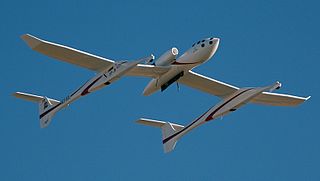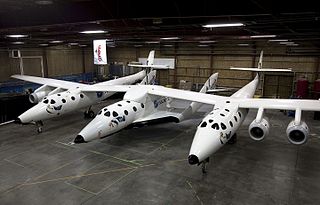
Scaled Composites is an American aerospace company founded by Burt Rutan and currently owned by Northrop Grumman. It is located at the Mojave Air and Space Port in Mojave, California, United States. Founded to develop experimental aircraft, the company now focuses on designing and developing concept craft and prototype fabrication processes for aircraft and other vehicles. It is known for unconventional designs, for its use of non-metal, composite materials, and for winning the Ansari X Prize with its experimental spacecraft SpaceShipOne.

The Ansari X Prize was a space competition in which the X Prize Foundation offered a US$10,000,000 prize for the first non-government organization to launch a reusable crewed spacecraft into space twice within two weeks. It was modeled after early 20th-century aviation prizes, and aimed to spur development of low-cost spaceflight.

SpaceShipOne is an experimental air-launched rocket-powered aircraft with sub-orbital spaceflight capability at speeds of up to 3,000 ft/s (2,000 mph) / 910 m/s (3,300 km/h) using a hybrid rocket motor. The design features a unique "feathering" atmospheric reentry system where the rear half of the wing and the twin tail booms folds 70 degrees upward along a hinge running the length of the wing; this increases drag while retaining stability. SpaceShipOne completed the first crewed private spaceflight in 2004. That same year, it won the US$10 million Ansari X Prize and was immediately retired from active service. Its mother ship was named "White Knight". Both craft were developed and flown by Mojave Aerospace Ventures, which was a joint venture between Paul Allen and Scaled Composites, Burt Rutan's aviation company. Allen provided the funding of approximately US$25 million.

Elbert Leander "Burt" Rutan is a retired American aerospace engineer and entrepreneur noted for his originality in designing light, strong, unusual-looking, and energy-efficient air and space craft. He designed the record-breaking Voyager, which in 1986 was the first plane to fly around the world without stopping or refueling, and the Virgin Atlantic GlobalFlyer, which in 2006 set the world record for the fastest and longest nonstop non-refueled circumnavigation flight in history. In 2004, Rutan's sub-orbital spaceplane design SpaceShipOne became the first privately funded spacecraft to enter the realm of space, winning the Ansari X-Prize that year for achieving the feat twice within a two-week period.

A sub-orbital spaceflight is a spaceflight in which the spacecraft reaches outer space, but its trajectory intersects the surface of the gravitating body from which it was launched. Hence, it will not complete one orbital revolution, will not become an artificial satellite nor will it reach escape velocity.

The Scaled Composites Model 318 White Knight is a jet-powered carrier aircraft that was used to launch its companion SpaceShipOne, an experimental spaceplane. The White Knight and SpaceShipOne were designed by Burt Rutan and manufactured by Scaled Composites, a private company founded by Rutan in 1982. On three separate flights in 2004, White Knight conducted SpaceShipOne into flight, and SpaceShipOne then performed a sub-orbital spaceflight, becoming the first private craft to reach space.

William Brian Binnie was a United States Navy officer and one of the test pilots for SpaceShipOne, the experimental spaceplane developed by Scaled Composites and flown from 2003 to 2004.
Peter Siebold is a member of the Scaled Composites astronaut team. He is their Director of Flight Operations, and was one of the test pilots for SpaceShipOne and SpaceShipTwo, the experimental spaceplanes developed by the company. On April 8, 2004, Siebold piloted the second powered test flight of SpaceShipOne, flight 13P, which reached a top speed of Mach 1.6 and an altitude of 32.0 kilometres (105,000 ft). On October 31, 2014, Siebold and Michael Alsbury were piloting the SpaceShipTwo VSS Enterprise on flight PF04, when the craft came apart in mid-air and then crashed, killing Alsbury and injuring Siebold.

Michael Winston Melvill is a world-record-breaking pilot and one of the test pilots for SpaceShipOne, the experimental spaceplane developed by Scaled Composites. Melvill piloted SpaceShipOne on its first flight past the edge of space, flight 15P on June 21, 2004, thus becoming the first commercial astronaut, and the 435th person to go into space. He was also the pilot on SpaceShipOne's flight 16P, the first competitive flight in the Ansari X Prize competition.

Flight 15P of SpaceShipOne (X0) was the first privately funded human spaceflight. It took place on June 21, 2004. It was the fourth powered test flight of the Tier One program, with the previous three test flights reaching much lower altitudes. The flight carried only its pilot, Mike Melvill, who thus became the first non-governmental astronaut.

The Mojave Air and Space Port at Rutan Field is in Mojave, California, United States, at an elevation of 2,801 feet (854 m). It is the first facility to be licensed in the United States for horizontal launches of reusable spacecraft, being certified as a spaceport by the Federal Aviation Administration on June 17, 2004. The facility covers 2,998 acres and has three runways.

Tier One was a Scaled Composites' 1990s–2004 program of suborbital human spaceflight using the reusable spacecraft SpaceShipOne and its launcher White Knight. The craft was designed by Burt Rutan, and the project was funded 20 million US Dollars by Paul Allen. In 2004 it made the first privately funded human spaceflight and won the 10 million US Dollars Ansari X Prize for the first non-governmental reusable crewed spacecraft.
Flight 11P of SpaceShipOne was its eighth independent flight, its first powered flight, and the first privately funded crewed flight to reach supersonic speeds. It occurred on December 17, 2003.

Flight 16P of SpaceShipOne was a spaceflight in the Tier One program that took place on September 29, 2004. It was the first competitive flight in the Ansari X PRIZE competition to demonstrate a non-governmental reusable crewed spacecraft, and is hence also referred to as the X1 flight. A serious roll excursion occurred during boost, so the flight did not achieve the expected altitude. However, it exceeded 100 km altitude, making it a successful X PRIZE flight.

Virgin Galactic is an American spaceflight company founded by Richard Branson and the Virgin Group conglomerate which retains an 11.9% stake through Virgin Investments Limited. It is headquartered in California, and operates from New Mexico. The company is developing commercial spacecraft and aims to provide suborbital spaceflights to space tourists. Virgin Galactic's suborbital spacecraft are air launched from beneath a carrier airplane known as White Knight Two. Virgin Galactic's maiden spaceflight occurred in 2018 with its VSS Unity spaceship. Branson had originally hoped to see a maiden spaceflight by 2010, but the date was delayed for several years, and then delayed again, primarily due to the October 2014 crash of VSS Enterprise.
Mojave Aerospace Ventures (MAV) is a company founded by Paul Allen and Burt Rutan to handle the commercial spinoffs from the Tier One project. It owns the intellectual property arising from Tier One, and it is in turn owned by Allen and Rutan's Scaled Composites. In 2004, it signed a deal with Virgin Galactic to develop the Virgin SpaceShip, a suborbital spacecraft, for space tourism. Virgin Group and Scaled Composites have subsequently formed a joint venture, The Spaceship Company, to manufacture the spacecraft.

The Scaled Composites Model 339 SpaceShipTwo (SS2) is an air-launched suborbital spaceplane type designed for space tourism. It is manufactured by The Spaceship Company, a California-based company owned by Virgin Galactic.

The VSS Enterprise crash occurred on October 31, 2014, when the VSS Enterprise, a SpaceShipTwo experimental spaceflight test vehicle operated by Virgin Galactic, suffered a catastrophic in-flight breakup during a test flight and crashed in the Mojave Desert near Cantil, California. Co-pilot Michael Alsbury was killed and pilot Peter Siebold was seriously injured.

VP-03 was a sub-orbital spaceflight of the SpaceShipTwo-class VSS Unity which took place on 13 December 2018, piloted by Mark P. Stucky and co-piloted by Frederick W. "CJ" Sturckow.























